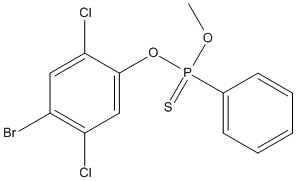Leptophos
derivatives include Leptophos-oxon CID: 32765 Velsicol fcs-303 CID: 167772 CID: 186940
General
Type : Insecticide,Organophosphate,Sulfur Compound,Organothiophosphate,OPIDN-OP
Chemical_Nomenclature : O-(4-bromo-2,5-dichlorophenyl) O-methyl phenylphosphonothioate
Canonical SMILES : COP(=S)(C1=CC=CC=C1)OC2=CC(=C(C=C2Cl)Br)Cl
InChI : InChI=1S\/C13H10BrCl2O2PS\/c1-17-19(20,9-5-3-2-4-6-9)18-13-8-11(15)10(14)7-12(13)16\/h2-8H,1H3
InChIKey : CVRALZAYCYJELZ-UHFFFAOYSA-N
Other name(s) : PhosvelMBCP,Abor,VCS 506,Letophos,lepton,O-(4-bromo-2,5-dichlorophenyl) O-methyl phenylphosphonothioate,ABAR,Fosvel,K62-105,Leptophos oxon,Leptophoxon,NK 711,Oleophosvel,Velsicol 506
MW : 412.06
Formula : C13H10BrCl2O2PS
CAS_number : 21609-90-5
PubChem : 30709
UniChem : CVRALZAYCYJELZ-UHFFFAOYSA-N
IUPHAR :
Wikipedia : Leptophos

Target
References (8)
| Title : Neurotoxic potential of six organophosphorus compounds in adult hens - Abdelsalam_1999_Vet.Hum.Toxicol_41_290 |
| Author(s) : Abdelsalam EB |
| Ref : Vet Hum Toxicol , 41 :290 , 1999 |
| Abstract : Abdelsalam_1999_Vet.Hum.Toxicol_41_290 |
| ESTHER : Abdelsalam_1999_Vet.Hum.Toxicol_41_290 |
| PubMedSearch : Abdelsalam_1999_Vet.Hum.Toxicol_41_290 |
| PubMedID: 10509429 |
| Title : Comparative effectiveness of organophosphorus protoxicant activating systems in neuroblastoma cells and brain homogenates - Barber_1999_J.Toxicol.Environ.Health_57_63 |
| Author(s) : Barber D , Correll L , Ehrich M |
| Ref : J Toxicol Environ Health , 57 :63 , 1999 |
| Abstract : Barber_1999_J.Toxicol.Environ.Health_57_63 |
| ESTHER : Barber_1999_J.Toxicol.Environ.Health_57_63 |
| PubMedSearch : Barber_1999_J.Toxicol.Environ.Health_57_63 |
| PubMedID: 10321902 |
| Title : Delayed neuropathy and inhibition of soluble neuropathy target esterase following the administration of organophosphorus compounds to hens - Tian_1998_Tohoku.J.Exp.Med_185_161 |
| Author(s) : Tian Y , Xie XK , Piao FY , Yamauchi T |
| Ref : Tohoku J Exp Med , 185 :161 , 1998 |
| Abstract : Tian_1998_Tohoku.J.Exp.Med_185_161 |
| ESTHER : Tian_1998_Tohoku.J.Exp.Med_185_161 |
| PubMedSearch : Tian_1998_Tohoku.J.Exp.Med_185_161 |
| PubMedID: 9823777 |
| Title : Compatibility of Metarhizium anisopliae var. anisopliae with chemical pesticides - Mohamed_1987_Mycopathologia_99_99 |
| Author(s) : Mohamed AK , Pratt JP , Nelson FR |
| Ref : Mycopathologia , 99 :99 , 1987 |
| Abstract : Mohamed_1987_Mycopathologia_99_99 |
| ESTHER : Mohamed_1987_Mycopathologia_99_99 |
| PubMedSearch : Mohamed_1987_Mycopathologia_99_99 |
| PubMedID: 3657906 |
| Title : Simplified cleanup and gas chromatographic determination of organophosphorus pesticides in crops - Sasaki_1987_J.Assoc.Off.Anal.Chem_70_460 |
| Author(s) : Sasaki K , Suzuki T , Saito Y |
| Ref : J Assoc Off Analytical Chemistry , 70 :460 , 1987 |
| Abstract : Sasaki_1987_J.Assoc.Off.Anal.Chem_70_460 |
| ESTHER : Sasaki_1987_J.Assoc.Off.Anal.Chem_70_460 |
| PubMedSearch : Sasaki_1987_J.Assoc.Off.Anal.Chem_70_460 |
| PubMedID: 3610958 |
| Title : The toxic and teratogenic effects of selected organophosphorus compounds on the embryos of three species of amphibians - Fulton_1985_Toxicol.Lett_26_175 |
| Author(s) : Fulton MH , Chambers JE |
| Ref : Toxicol Lett , 26 :175 , 1985 |
| Abstract : Fulton_1985_Toxicol.Lett_26_175 |
| ESTHER : Fulton_1985_Toxicol.Lett_26_175 |
| PubMedSearch : Fulton_1985_Toxicol.Lett_26_175 |
| PubMedID: 4035710 |
| Title : Delayed neurotoxicity of leptophos and related compounds: differential effects of subchronic oral administration of pure, technical grade and degradation products on the hen - |
| Author(s) : Abou-Donia MB , Graham DG , Ashry MA , Timmons PR |
| Ref : Toxicol Appl Pharmacol , 53 :150 , 1980 |
| PubMedID: 6155716 |
| Title : Evaluation of cytotoxic responses caused by selected organophosphorus esters in chick sympathetic ganglia cultures - Obersteiner_1978_Can.J.Comp.Med_42_80 |
| Author(s) : Obersteiner EJ , Sharma RP |
| Ref : Can J Comp Med , 42 :80 , 1978 |
| Abstract : Obersteiner_1978_Can.J.Comp.Med_42_80 |
| ESTHER : Obersteiner_1978_Can.J.Comp.Med_42_80 |
| PubMedSearch : Obersteiner_1978_Can.J.Comp.Med_42_80 |
| PubMedID: 565668 |